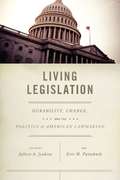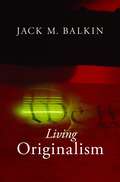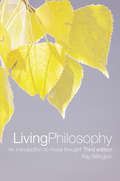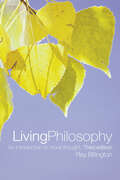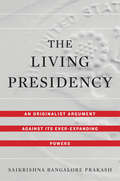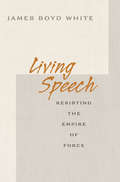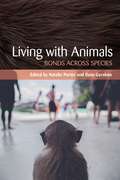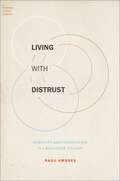- Table View
- List View
Living Legislation: Durability, Change, and the Politics of American Lawmaking
by Jenkins, Jeffery; Patashnik, Eric M.Politics is at its most dramatic during debates over important pieces of legislation. It is thus no stretch to refer to legislation as a living, breathing force in American politics. And while debates over legislative measures begin before an item is enacted, they also endure long afterward, when the political legacy of a law becomes clear. Living Legislation provides fresh insights into contemporary American politics and public policy. Of particular interest to the contributors to this volume is the question of why some laws stand the test of time while others are eliminated, replaced, or significantly amended. Among the topics the essays discuss are how laws emerge from—and effect change within—coalition structures, the effectiveness of laws at mediating partisan conflicts, and the ways in which laws interact with broader shifts in the political environment. As an essential addition to the study of politics, Living Legislation enhances understanding of democracy, governance, and power.
Living Legislation: Durability, Change, and the Politics of American Lawmaking
by Jenkins, Jeffery; Patashnik, Eric M.Politics is at its most dramatic during debates over important pieces of legislation. It is thus no stretch to refer to legislation as a living, breathing force in American politics. And while debates over legislative measures begin before an item is enacted, they also endure long afterward, when the political legacy of a law becomes clear. Living Legislation provides fresh insights into contemporary American politics and public policy. Of particular interest to the contributors to this volume is the question of why some laws stand the test of time while others are eliminated, replaced, or significantly amended. Among the topics the essays discuss are how laws emerge from—and effect change within—coalition structures, the effectiveness of laws at mediating partisan conflicts, and the ways in which laws interact with broader shifts in the political environment. As an essential addition to the study of politics, Living Legislation enhances understanding of democracy, governance, and power.
Living Legislation: Durability, Change, and the Politics of American Lawmaking
by Jenkins, Jeffery; Patashnik, Eric M.Politics is at its most dramatic during debates over important pieces of legislation. It is thus no stretch to refer to legislation as a living, breathing force in American politics. And while debates over legislative measures begin before an item is enacted, they also endure long afterward, when the political legacy of a law becomes clear. Living Legislation provides fresh insights into contemporary American politics and public policy. Of particular interest to the contributors to this volume is the question of why some laws stand the test of time while others are eliminated, replaced, or significantly amended. Among the topics the essays discuss are how laws emerge from—and effect change within—coalition structures, the effectiveness of laws at mediating partisan conflicts, and the ways in which laws interact with broader shifts in the political environment. As an essential addition to the study of politics, Living Legislation enhances understanding of democracy, governance, and power.
The Living Organ Donor as Patient: Theory and Practice
by Lainie Friedman Ross J. Richard Thistlethwaite, Jr.When Joseph Murray performed the first successful living kidney donor transplant in 1954, he thought this would be a temporary stopgap. Today, we are no closer to the goal of adequate organ supply without living donors--if anything, the supply-demand ratio is worse. While most research on the ethics of organ transplantation focuses on how to allocate organs as a scarce medical resource, the ethical treatment of organ donors themselves has been relatively neglected. In The Living Organ Donor as Patient: Theory and Practice, Lainie Friedman Ross and J. Richard Thistlethwaite, Jr. argue that living donor organ transplantation can be ethical provided that we treat living solid organ donors as patients in their own right. Ross and Thistlethwaite develop a five-principle framework to examine some of the attempts to increase living donation. It uses the three principles of the Belmont Report: respect for persons, beneficence, and justice modified to organ transplantation, as well as the principles of vulnerability and special relationships creating special obligations. Their approach requires that the transplant community fully embrace current and prospective living organ donors as patients to whom we have special obligations. Only when living organ donors are regarded as patients in their own right and have a living donor advocate team dedicated to their well-being can the moral limits of living solid organ donation be realized and living donors be given the full respect and care they deserve.
The Living Organ Donor as Patient: Theory and Practice
by Lainie Friedman Ross J. Richard Thistlethwaite, Jr.When Joseph Murray performed the first successful living kidney donor transplant in 1954, he thought this would be a temporary stopgap. Today, we are no closer to the goal of adequate organ supply without living donors--if anything, the supply-demand ratio is worse. While most research on the ethics of organ transplantation focuses on how to allocate organs as a scarce medical resource, the ethical treatment of organ donors themselves has been relatively neglected. In The Living Organ Donor as Patient: Theory and Practice, Lainie Friedman Ross and J. Richard Thistlethwaite, Jr. argue that living donor organ transplantation can be ethical provided that we treat living solid organ donors as patients in their own right. Ross and Thistlethwaite develop a five-principle framework to examine some of the attempts to increase living donation. It uses the three principles of the Belmont Report: respect for persons, beneficence, and justice modified to organ transplantation, as well as the principles of vulnerability and special relationships creating special obligations. Their approach requires that the transplant community fully embrace current and prospective living organ donors as patients to whom we have special obligations. Only when living organ donors are regarded as patients in their own right and have a living donor advocate team dedicated to their well-being can the moral limits of living solid organ donation be realized and living donors be given the full respect and care they deserve.
Living Originalism
by Jack M. BalkinOriginalism and living constitutionalism, so often understood to be diametrically opposing views of our nation’s founding document, are not in conflict—they are compatible. So argues Jack Balkin, one of the leading constitutional scholars of our time, in this long-awaited book. Step by step, Balkin gracefully outlines a constitutional theory that demonstrates why modern conceptions of civil rights and civil liberties, and the modern state’s protection of national security, health, safety, and the environment, are fully consistent with the Constitution’s original meaning. And he shows how both liberals and conservatives, working through political parties and social movements, play important roles in the ongoing project of constitutional construction. By making firm rules but also deliberately incorporating flexible standards and abstract principles, the Constitution’s authors constructed a framework for politics on which later generations could build. Americans have taken up this task, producing institutions and doctrines that flesh out the Constitution’s text and principles. Balkin’s analysis offers a way past the angry polemics of our era, a deepened understanding of the Constitution that is at once originalist and living constitutionalist, and a vision that allows all Americans to reclaim the Constitution as their own.
Living Philosophy: An Introduction to Moral Thought
by Ray BillingtonFirst published in 2003. Routledge is an imprint of Taylor & Francis, an informa company.
Living Philosophy: An Introduction to Moral Thought
by Ray BillingtonFirst published in 2003. Routledge is an imprint of Taylor & Francis, an informa company.
The Living Presidency: An Originalist Argument against Its Ever-Expanding Powers
by Saikrishna Bangalore PrakashA constitutional originalist sounds the alarm over the presidency’s ever-expanding powers, ascribing them unexpectedly to the liberal embrace of a living Constitution. Liberal scholars and politicians routinely denounce the imperial presidency—a self-aggrandizing executive that has progressively sidelined Congress. Yet the same people invariably extol the virtues of a living Constitution, whose meaning adapts with the times. Saikrishna Bangalore Prakash argues that these stances are fundamentally incompatible. A constitution prone to informal amendment systematically favors the executive and ensures that there are no enduring constraints on executive power. In this careful study, Prakash contends that an originalist interpretation of the Constitution can rein in the “living presidency” legitimated by the living Constitution. No one who reads the Constitution would conclude that presidents may declare war, legislate by fiat, and make treaties without the Senate. Yet presidents do all these things. They get away with it, Prakash argues, because Congress, the courts, and the public routinely excuse these violations. With the passage of time, these transgressions are treated as informal constitutional amendments. The result is an executive increasingly liberated from the Constitution. The solution is originalism. Though often associated with conservative goals, originalism in Prakash’s argument should appeal to Republicans and Democrats alike, as almost all Americans decry the presidency’s stunning expansion. The Living Presidency proposes a baker’s dozen of reforms, all of which could be enacted if only Congress asserted its lawful authority.
Living Speech: Resisting the Empire of Force
by James Boyd WhiteLanguage is our key to imagining the world, others, and ourselves. Yet sometimes our ways of talking dehumanize others and trivialize human experience. In war other people are imagined as enemies to be killed. The language of race objectifies those it touches, and propaganda disables democracy. Advertising reduces us to consumers, and clichés destroy the life of the imagination. How are we to assert our humanity and that of others against the forces in the culture and in our own minds that would deny it? What kind of speech should the First Amendment protect? How should judges and justices themselves speak? These questions animate James Boyd White's Living Speech, a profound examination of the ethics of human expression--in the law and in the rest of life. Drawing on examples from an unusual range of sources--judicial opinions, children's essays, literature, politics, and the speech-out-of-silence of Quaker worship--White offers a fascinating analysis of the force of our languages. Reminding us that every moment of speech is an occasion for gaining control of what we say and who we are, he shows us that we must practice the art of resisting the forces of inhumanity built into our habits of speech and thought if we are to become more capable of love and justice--in both law and life.
Living Speech: Resisting the Empire of Force
by James Boyd WhiteLanguage is our key to imagining the world, others, and ourselves. Yet sometimes our ways of talking dehumanize others and trivialize human experience. In war other people are imagined as enemies to be killed. The language of race objectifies those it touches, and propaganda disables democracy. Advertising reduces us to consumers, and clichés destroy the life of the imagination. How are we to assert our humanity and that of others against the forces in the culture and in our own minds that would deny it? What kind of speech should the First Amendment protect? How should judges and justices themselves speak? These questions animate James Boyd White's Living Speech, a profound examination of the ethics of human expression--in the law and in the rest of life. Drawing on examples from an unusual range of sources--judicial opinions, children's essays, literature, politics, and the speech-out-of-silence of Quaker worship--White offers a fascinating analysis of the force of our languages. Reminding us that every moment of speech is an occasion for gaining control of what we say and who we are, he shows us that we must practice the art of resisting the forces of inhumanity built into our habits of speech and thought if we are to become more capable of love and justice--in both law and life.
Living Technology: Philosophy and Ethics at the Crossroads Between Life and Technology
by Armin GrunwaldThe boundaries between inanimate technology and the realm of the living become increasingly blurred. Deeper and deeper technological interventions into living organisms are possible, covering the entire spectrum of life from bacteria to humans. Simultaneously, digitalization and artificial intelligence (AI) enable increasingly autonomous technologies. Inanimate technologies such as robots begin to show characteristics of life. Contested issues pop up, such as the dignity of life, the enhancement of animals for human purposes, the creation of designer babies, and the granting of robot rights. The book addresses the understanding of the ongoing dissolution of the life/technology borders, the provision of ethical guidance for navigating research and innovation responsibly, and the philosophical reflection on the meaning of the current shifts. It offers three specific perspectives for understanding the challenges and providing orientation. First, the dissolution of the boundaries between technology and life is analyzed and reflected from both sides. Second, the search for orientation is not restricted to ethics but also involves philosophy of technology and of nature, as well as anthropology. Finally, instead of restricting the analysis to specific areas of life, e.g., bacteria or animals, the book presents a comprehensive look at the entire spectrum of living organisms—bacteria and viruses, plants, animals and humans—and robots as possible early forms of emerging technical life.
Living Technology: Philosophy and Ethics at the Crossroads Between Life and Technology
by Armin GrunwaldThe boundaries between inanimate technology and the realm of the living become increasingly blurred. Deeper and deeper technological interventions into living organisms are possible, covering the entire spectrum of life from bacteria to humans. Simultaneously, digitalization and artificial intelligence (AI) enable increasingly autonomous technologies. Inanimate technologies such as robots begin to show characteristics of life. Contested issues pop up, such as the dignity of life, the enhancement of animals for human purposes, the creation of designer babies, and the granting of robot rights. The book addresses the understanding of the ongoing dissolution of the life/technology borders, the provision of ethical guidance for navigating research and innovation responsibly, and the philosophical reflection on the meaning of the current shifts. It offers three specific perspectives for understanding the challenges and providing orientation. First, the dissolution of the boundaries between technology and life is analyzed and reflected from both sides. Second, the search for orientation is not restricted to ethics but also involves philosophy of technology and of nature, as well as anthropology. Finally, instead of restricting the analysis to specific areas of life, e.g., bacteria or animals, the book presents a comprehensive look at the entire spectrum of living organisms—bacteria and viruses, plants, animals and humans—and robots as possible early forms of emerging technical life.
Living Together: Essays on Aristotle's Ethics
by Jennifer WhitingLiving Together: Essays on Aristotle's Ethics is one of three volumes collecting previously published essays by Jennifer Whiting. This volume explores Aristotle's conception of eudaimonia, especially the roles played in it by the theoretical and practical activities central to human lives and by the quality of our relationships with one another. Whiting explores Aristotle's struggle to reconcile the desirability of living in accordance with justice and other distinctively human virtues with the ideal of pursuing the "divine" life of contemplation. She focuses on Aristotle's attempts to reconcile his conception of eudaimonia as the ultimate end of human action with the parallel requirements that virtuous agents choose to engage in virtuous action "for itself" and that friends love their friends "for themselves". Drawing on her original reading of Aristotle's conception of the ideal friend as an "other self", Whiting challenges common readings of Aristotle's eudaimonism as a form of rational egoism. She stresses appreciation of the friend's character "for itself", and apart from any relationships in which it happens to stand to the agent's own needs and/or tastes, but calls attention to the important and often neglected role that Aristotle assigns to pleasure in this relationship. The ideal friend recognizes the value her friend's activity has for her friend and so takes pleasure in the friend's activity as such. This explains why the maximally self-sufficient (and so most godlike) agent, who needs nothing from a friend, will nevertheless choose to have at least one or two: she enjoys their company.
Living Together: Essays on Aristotle's Ethics
by Jennifer WhitingLiving Together: Essays on Aristotle's Ethics is one of three volumes collecting previously published essays by Jennifer Whiting. This volume explores Aristotle's conception of eudaimonia, especially the roles played in it by the theoretical and practical activities central to human lives and by the quality of our relationships with one another. Whiting explores Aristotle's struggle to reconcile the desirability of living in accordance with justice and other distinctively human virtues with the ideal of pursuing the "divine" life of contemplation. She focuses on Aristotle's attempts to reconcile his conception of eudaimonia as the ultimate end of human action with the parallel requirements that virtuous agents choose to engage in virtuous action "for itself" and that friends love their friends "for themselves". Drawing on her original reading of Aristotle's conception of the ideal friend as an "other self", Whiting challenges common readings of Aristotle's eudaimonism as a form of rational egoism. She stresses appreciation of the friend's character "for itself", and apart from any relationships in which it happens to stand to the agent's own needs and/or tastes, but calls attention to the important and often neglected role that Aristotle assigns to pleasure in this relationship. The ideal friend recognizes the value her friend's activity has for her friend and so takes pleasure in the friend's activity as such. This explains why the maximally self-sufficient (and so most godlike) agent, who needs nothing from a friend, will nevertheless choose to have at least one or two: she enjoys their company.
Living Up to Death
by Paul RicoeurWhen French philosopher Paul Ricoeur died in 2005, he bequeathed to the world a highly regarded, widely influential body of work which established him as one of the greatest thinkers of our time. He also left behind a number of unfinished projects that are gathered here and translated into English for the first time. Living Up to Death consists of one major essay and nine fragments. Composed in 1996, the essay is the kernel of an unrealized book on the subject of mortality. Likely inspired by his wife’s approaching death, it examines not one’s own passing but one’s experience of others dying. Ricoeur notes that when thinking about death the imagination is paramount, since we cannot truly experience our own passing. But those we leave behind do, and Ricoeur posits that the idea of life after death originated in the awareness of our own end posthumously resonating with our survivors. The fragments in this volume were written over the course of the last few months of Ricoeur’s life as his health failed, and they represent his very last work. They cover a range of topics, touching on biblical scholarship, the philosophy of language, and the idea of selfhood he first addressed in Oneself as Another. And while they contain numerous philosophical insights, these fragments are perhaps most significant for providing an invaluable look at Ricoeur’s mind at work. As poignant as it is perceptive, Living Up to Death is a moving testimony to Ricoeur’s willingness to confront his own mortality with serious questions, a touching insouciance, and hope for the future.
Living Up to Death
by Paul RicoeurWhen French philosopher Paul Ricoeur died in 2005, he bequeathed to the world a highly regarded, widely influential body of work which established him as one of the greatest thinkers of our time. He also left behind a number of unfinished projects that are gathered here and translated into English for the first time. Living Up to Death consists of one major essay and nine fragments. Composed in 1996, the essay is the kernel of an unrealized book on the subject of mortality. Likely inspired by his wife’s approaching death, it examines not one’s own passing but one’s experience of others dying. Ricoeur notes that when thinking about death the imagination is paramount, since we cannot truly experience our own passing. But those we leave behind do, and Ricoeur posits that the idea of life after death originated in the awareness of our own end posthumously resonating with our survivors. The fragments in this volume were written over the course of the last few months of Ricoeur’s life as his health failed, and they represent his very last work. They cover a range of topics, touching on biblical scholarship, the philosophy of language, and the idea of selfhood he first addressed in Oneself as Another. And while they contain numerous philosophical insights, these fragments are perhaps most significant for providing an invaluable look at Ricoeur’s mind at work. As poignant as it is perceptive, Living Up to Death is a moving testimony to Ricoeur’s willingness to confront his own mortality with serious questions, a touching insouciance, and hope for the future.
The Living Wage: Advancing a Global Movement
by Tony DobbinsAs wealth inequality skyrockets and trade union power declines, the living wage movement has become ever more urgent for public policymakers, academics, and – most importantly – those workers whose wages hover close to the breadline. A real living wage in any part of the world is rarely its minimum wage: it is the minimum income needed to cover living costs and participate fully in society. Most governments’ minimum wages are still falling short, meaning millions of workers struggle to cover their living costs. This book brings new, vital insights to the conversation from a carefully selected group of contributors at the forefront of this field. By juxtaposing advances across sectors and countries, and encompassing many different approaches and indeed definitions of the living wage, Dobbins and Prowse offer a rich tapestry of approaches that may inform public policy. By including the experiences and voices of those workers earning at, or near, the living wage alongside the opinions of leading experts in this field, this book is a pioneering contribution for public policymakers as well as students and academics of work and employment relations, public policy, organizational studies, social economics, and politics.
The Living Wage: Advancing a Global Movement
by Tony Dobbins Peter ProwseAs wealth inequality skyrockets and trade union power declines, the living wage movement has become ever more urgent for public policymakers, academics, and – most importantly – those workers whose wages hover close to the breadline. A real living wage in any part of the world is rarely its minimum wage: it is the minimum income needed to cover living costs and participate fully in society. Most governments’ minimum wages are still falling short, meaning millions of workers struggle to cover their living costs. This book brings new, vital insights to the conversation from a carefully selected group of contributors at the forefront of this field. By juxtaposing advances across sectors and countries, and encompassing many different approaches and indeed definitions of the living wage, Dobbins and Prowse offer a rich tapestry of approaches that may inform public policy. By including the experiences and voices of those workers earning at, or near, the living wage alongside the opinions of leading experts in this field, this book is a pioneering contribution for public policymakers as well as students and academics of work and employment relations, public policy, organizational studies, social economics, and politics.
Living Wage: Regulatory Solutions to Informal and Precarious Work in Global Supply Chains (Oxford Labour Law)
by Shelley MarshallThis book is driven by a quest to re-regulate work to reduce informality and inequality, and promote a living wage for more people across the world. It presents the findings of a multidisciplinary study in four countries of varying wealth and development, exploring why people become trapped in precarious work. The accounts describe the impact of supply chain governance, trade agreements, internal and between-country migration, legal factors, as well as the socio-economic characteristics and outlooks of the workers. In a unique approach, the chapters describe existing labour regulation measures that have succeeded, but which have to date attracted little scholarly attention. Building on these existing innovations, the book proposes a new international labour law which would incrementally increase the wages of the poor and regulate precarious work in global supply chains.
Living Wage: Regulatory Solutions to Informal and Precarious Work in Global Supply Chains (Oxford Labour Law)
by Shelley MarshallThis book is driven by a quest to re-regulate work to reduce informality and inequality, and promote a living wage for more people across the world. It presents the findings of a multidisciplinary study in four countries of varying wealth and development, exploring why people become trapped in precarious work. The accounts describe the impact of supply chain governance, trade agreements, internal and between-country migration, legal factors, as well as the socio-economic characteristics and outlooks of the workers. In a unique approach, the chapters describe existing labour regulation measures that have succeeded, but which have to date attracted little scholarly attention. Building on these existing innovations, the book proposes a new international labour law which would incrementally increase the wages of the poor and regulate precarious work in global supply chains.
Living with Animals: Bonds across Species
Living with Animals is a collection of imagined animal guides—a playful and accessible look at different human-animal relationships around the world. Anthropologists and their co-authors have written accounts of how humans and animals interact in labs, in farms, in zoos, and in African forests, among other places. Modeled after the classic A World of Babies, an edited collection of imagined Dr. Spock manuals from around the world—With Animals focuses on human-animal relationships in their myriad forms.This is ethnographic fiction for those curious about how animals are used for a variety of different tasks around the world. To be sure, animal guides are not a universal genre, so Living with Animals offers an imaginative solution, doing justice to the ways details about animals are conveyed in culturally specific ways by adopting a range of voices and perspectives. How we capitalize on animals, how we live with them, and how humans attempt to control the untamable nature around them are all considered by the authors of this wild read.If you have ever experienced a moment of "what if" curiosity—what is it like to be a gorilla in a zoo, to work in a pig factory farm, to breed cows and horses, this book is for you. A light-handed and light-hearted approach to a fascinating and nuanced subject, Living with Animals suggests many ways in which we can and do coexist with our non-human partners on Earth.
Living with Dementia: Neuroethical Issues and International Perspectives (Advances in Neuroethics)
by Veljko Dubljević Frances BottenbergThis book addresses current issues in the neuroscience and ethics of dementia care, including philosophical as well as ethical legal, and social issues (ELSIs), issues in clinical, institutional, and private care-giving, and international perspectives on dementia and care innovations. As such, it is a must-read for anyone interested in a well-researched, thought-provoking overview of current issues in dementia diagnosis, care, and social and legal policy. All contributions reflect the latest neuroscientific research on dementia, either broadly construed or in terms of the etiologies and symptoms of particular forms of dementia. Given its interdisciplinary and international scope, its depth of research, and its qualitative emphasis, the book represents a valuable addition to the available literature on neuroethics, gerontology, and neuroscientific memory research.
Living with Distrust: Morality and Cooperation in a Romanian Village (Foundations of Human Interaction)
by Radu UmbresPeople in the Romanian village of Sateni distrust each other so much, that they would rather take a building apart than share it. Satenis think of life as struggle for scarce resources--a struggle that can lead to deception, exploitation, or predation. Cooperation with unrelated or unfamiliar partners fails while distrust permeates everyday life and cultural representations. Yet, each person engages in profound relationships with a particular set of people, expressed in cooperative actions. Living in Distrust makes sense of this worldview-one divided between strong moral relationships and deep suspicion towards the rest of the village society-through an ethnography of distrust. Drawing on two years of fieldwork, Radu Umbres offers an interdisciplinary interpretation of social interactions in a low trust society. This cognitive ethnography argues that the costs of misplaced trust made Sateni restrict their cooperative behavior to a safe set of social relationships: family, kinship, and friendship ties. Umbres explains how mutual trust appears by social agreement around culturally-codified institutions and persists only by fair cooperative interactions. Despite scarce representations or investments in the common good, the village society reproduces its low-level equilibrium of cooperation in relative stability. In an exploration of the structural influences on community morality and a defense of distrust, the book also demonstrates how investing trust in family first is an optimal strategy against ecological or political risks. By highlighting a system of dual morality sharply distinct from the Western-liberal ethos, Living with Distrust addresses perennial moral dilemmas and essential questions of secrecy and honesty, distrust and reputation.
Living with Distrust: Morality and Cooperation in a Romanian Village (Foundations of Human Interaction)
by Radu UmbresPeople in the Romanian village of Sateni distrust each other so much, that they would rather take a building apart than share it. Satenis think of life as struggle for scarce resources--a struggle that can lead to deception, exploitation, or predation. Cooperation with unrelated or unfamiliar partners fails while distrust permeates everyday life and cultural representations. Yet, each person engages in profound relationships with a particular set of people, expressed in cooperative actions. Living in Distrust makes sense of this worldview-one divided between strong moral relationships and deep suspicion towards the rest of the village society-through an ethnography of distrust. Drawing on two years of fieldwork, Radu Umbres offers an interdisciplinary interpretation of social interactions in a low trust society. This cognitive ethnography argues that the costs of misplaced trust made Sateni restrict their cooperative behavior to a safe set of social relationships: family, kinship, and friendship ties. Umbres explains how mutual trust appears by social agreement around culturally-codified institutions and persists only by fair cooperative interactions. Despite scarce representations or investments in the common good, the village society reproduces its low-level equilibrium of cooperation in relative stability. In an exploration of the structural influences on community morality and a defense of distrust, the book also demonstrates how investing trust in family first is an optimal strategy against ecological or political risks. By highlighting a system of dual morality sharply distinct from the Western-liberal ethos, Living with Distrust addresses perennial moral dilemmas and essential questions of secrecy and honesty, distrust and reputation.

